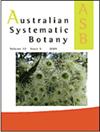Marine planktonic dinophysoid dinoflagellates (order Dinophysales): 60 years of species-level distributions in Australian waters
IF 1.6
3区 生物学
Q4 EVOLUTIONARY BIOLOGY
引用次数: 0
Abstract
ABSTRACT We reviewed 9350 Australian species-level records and confirmed 64 species of the marine planktonic dinoflagellate genera Dinophysis Ehrenb. (17 species), Phalacroma F.Stein (12), Metaphalacroma L.S.Tai (1), Pseudophalacroma Jörg. (1), Ornithocercus F.Stein (7), Histioneis F.Stein (11 spp.), Parahistioneis Kof. & Skogsb. (4), Histiophysis (Kof. & Mich.) Kof. & Skogsb. (1), Citharistes F.Stein (2) and Amphisolenia F.Stein (8), from the period 1938–2019. The widespread D. acuminata Clap. & J.Lachm., D. acuta Ehrenb., D. caudata Kent, D. fortii Pavill., and D. tripos Gourret have attracted attention as causative organisms of diarrhetic shellfish poisoning in temperate Australian waters. We discriminate between Dinophysis and Phalacroma. We newly report from Australian waters O. assimilis Jörg., Metaphalacroma skogsbergii L.S.Tai, Parahistioneis pieltainii Osorio-Taffal, Amphisolenia extensa Kof., A. inflata G.Murr. & Whitt. and A. rectangulata Kof. We rediscovered Histiophysis rugosa (Kof. & Mich.) Kof. & Skogsb. here illustrated with two cells from the Coral Sea. The ornate tropical genera Ornithocercus and Histioneis are excellent warm-water indicators, reflecting the southward reach of the East Australian and Leeuwin currents, whereas D. truncata Cleve is a cold-water Subantarctic species.海洋浮游甲藻目甲藻:澳大利亚水域60年物种水平分布
摘要:我们查阅了9350份澳大利亚物种级记录,确认了64种海洋浮游甲藻属。(17种),Phalacroma F.Stein(12种),Metaphalacroma L.S.Tai(1种),Pseudophalacromma Jörg。(1) ,Ornithocercus F.Stein(7),Hisioneis F.Stein11 spp.,Parahisioneis Kof.&Skogsb。(4) ,组织生理学(Kof.&Mich.)Kof.&Skogsb。(1) ,Citharistes F.Stein(2)和Amphilolenia F.Stein,(8),1938-1919年。广泛分布的D.acuminata Clap.&J.Lachm.,D.acuta-Ehrenb。,D.caudata Kent,D.fortii Pavil。,和D.tripos Gourret作为澳大利亚温带水域腹泻性贝类中毒的病原体引起了人们的关注。我们区分Dinophysis和Phalacroma。我们最新报道来自澳大利亚水域O.assimilis Jörg。,skogsbergii L.S.Tai、Osorio-Taffal副组氨酸、Amphilenia extensa Kof。,A.充气G.Murr.&Whitt。和A.rectangulata Kof。我们重新发现了皱皮组织(Kof.&Mich.)Kof.&Skogsb。这里用来自珊瑚海的两个细胞进行了说明。华丽的热带属Ornithocercus和Hisioneis是极好的暖水指标,反映了东澳大利亚和列文洋流的向南延伸,而D.truncata Cleve是冷水亚南极物种。
本文章由计算机程序翻译,如有差异,请以英文原文为准。
求助全文
约1分钟内获得全文
求助全文
来源期刊

Australian Systematic Botany
生物-进化生物学
CiteScore
3.10
自引率
12.50%
发文量
12
审稿时长
>12 weeks
期刊介绍:
Australian Systematic Botany is an international journal devoted to the systematics, taxonomy, and related aspects of biogeography and evolution of all algae, fungi and plants, including fossils. Descriptive taxonomic papers should normally constitute a comprehensive treatment of a group. Short papers on individual species and nomenclatural papers must contain significant new information of broader interest to be considered. The prestigious L.A.S. Johnson Review Series is published. Other review articles will also be considered. All papers are peer reviewed.
Australian Systematic Botany is published with the endorsement of the Commonwealth Scientific and Industrial Research Organisation (CSIRO) and the Australian Academy of Science.
 求助内容:
求助内容: 应助结果提醒方式:
应助结果提醒方式:


